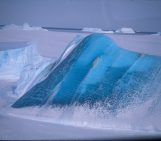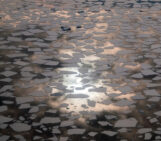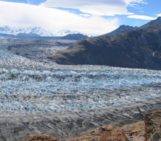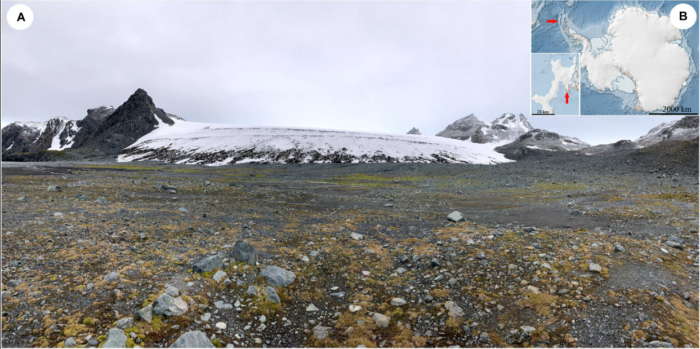
In 2020, ocean scientists discovered a new island off the Pine Island Glacier ice shelf, naming it after the Norse goddess, Sif. The island is one of many new regions being exposed in the wake of increased ice shelf melting and glacial retreat. While these newly-revealed lands have been discussed in the Arctic and alpine ecosystems, the uncovered island and coastlines of Antarctica have been less thoroughly studied. In this article, we briefly explore the potential ecological succession of these new areas, as well as our own role in this new era of Antarctic exploration.
From obscurity to the spotlight
Since the fourth century BC, Antarctica has held our imagination, first conceptualized to reflect the mass and winds at the northern pole. It wasn’t until the 19th century that Terra Australis Incognita moved from a fantasy to reality. On January 27th, 1820, at 9am, Fabian Gottlieb von Bellingshausen first laid eyes on the seventh continent, describing the moment as:
We hauled close to the wind on a south-east course and had made 2 miles in this direction when we observed that there was a solid stretch of ice running from east through south to west. Our course was leading us straight in to this field, which was covered with ice hillocks. […] During the last 24 hours we had observed snow-white and blue petrels and heard the cries of penguins.
Bellinghausen shed a spotlight on the Southern Pole and, consequently, opened the gates for the world to witness Antarctica. Over 200 years later, Antarctica has the unique status of being both fantastical and accessible, with over 100,000 tourists visiting the end of the world during the 2022-23 season. As the number of Antarctic visitors continues to grow, Antarctica’s acclaim as the last frontier may begin to diminish, eventually losing the allure of exploration that enticed so many poleward travelers. But what if there are new Antarctic regions to explore beneath the ice?
A real icebreaker
In recent decades, the Antarctic coastline has experienced rapid glacial melt and sea ice disintegration due to increased warming in the atmosphere and ocean. With the receding of Antarctic ice comes widespread habitat loss and ecosystem shifting, particularly along the Antarctic Peninsula where melting is most pronounced. But sometimes, what remains in the ice cap’s absence are previously covered islands and coastlines. Reports of these uncharted lands are popping up across the icy continent, like the newly discovered Sif Island off the Pine Island Glacier ice shelf (Figure 2). Made of volcanic granite, Sif Island may have actually risen out of the ocean once the retreating ice sheet no longer bore down on it, a process known as post-glacial rebound. Along with rocky surfaces, massive unmoving mounds of ice, or ice islands, may be revealed as ice shelves break up. Such a structure was found after the disintegration of the Glenzer-Conger Ice Shelf, and the unnamed island stood 30-40 meters above sea level. More post-glacial areas are expected to appear over the next century, with the retreat of Antarctic glaciers may expose approximately 7,600 km² of overdeepened surfaces. As more ice shelves continue to melt under anthropogenic climate change, we should expect more Antarctic land to become visible with each future, hotter year. And with the loss of one habitat, the Antarctic ecosystem may adapt and reconfigure to a new substrate.
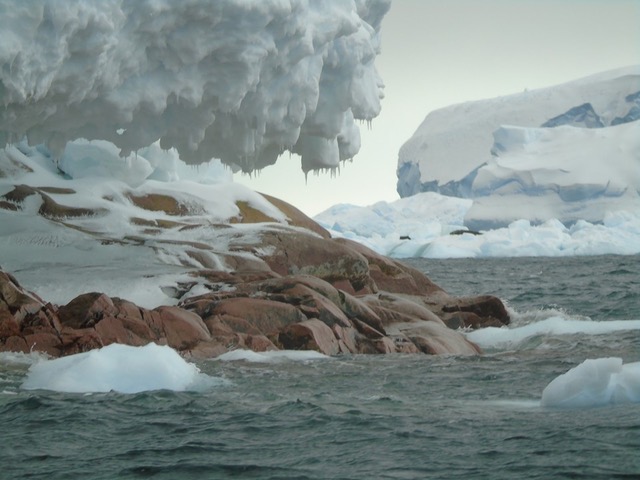
Figure 2. Picture of the granite coast of Sif Island underneath a mound of Antarctic ice. [Photo credit to CD Hillenbrand (BAS) and Laura Taylor (UH)]
First Come, First Marine Ecological Swerve
Predicting what Antarctic biota takes over these new habitats is tricky due to several natural variables: coastline proximity, ocean circulation, region of the continent, and a slew of other factors. Among these environmental influences, ecosystems across the continent are especially structured around the presence of sea ice, which provides habitat and protection from potential predators. But as the ice begins to melt away, the Antarctic ecosystem may need to adapt and transition from being ice-reliant to ice-independent.
In the surrounding waters, the first transitions may be seen at the plankton base of the marine food web. Along the Antarctic Peninsula, the distribution of photosynthesizing phytoplankton were linked to several environmental components, including sea ice extent. As the previously ice-covered southern regions experienced more ice-free days, the phytoplankton community shifted to having more diatoms and larger cells; hence, we may expect larger phytoplankton to bloom in other areas previously covered by sea ice. Moving up the food chain, ice-free waters could simultaneously lead to declines of the ice-dependent krill and favor the more versatile salps. Thus begins a chain reaction of ecosystem shifting for the above-ice world, with predators throughout the Antarctic food web vying to adjust to new prey and habitats. Along the Antarctic Peninsula, the subantarctic Gentoo penguins are growing in numbers and moving southward, encroaching into previously ice-dominated Adélie penguin territories. These marine predators, along with seals and seabirds, may be the first ones to inhabit the new islands, as seen by the seals already having moved onto Sif Island (Figure 3).
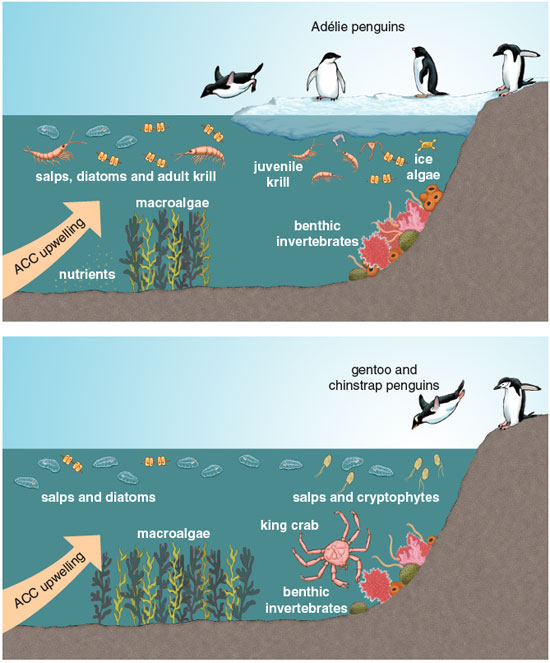
Figure 3. illustrates the potential differences in the West Antarctic Peninsula ecosystem with and without the presence of sea ice, one of many environmental factors influencing the biological community. In the top panel, juvenile krill feed on the algae under the ice, while Adelie penguins feed where the Antarctic Circumpolar Current (ACC) provides nutrients. As the ice disappears in the bottom panel, the ice-dependent krill and Adelie penguins may be replaced by salps, cryptophytes, and ice-tolerant penguin species like Gentoos and Chinstraps. [Credit to Barbara Aulicino]
Finders Keepers and Losers Compete for New Terrestrial Surfaces
On land, we can look at other post-glacial islands to understand the potential ecological succession of terrestrial biota. During the 23-year retreat of the Hurd Glacier on Livingston Island, the microbial community spread and diversified over time, shifting from primarily photosynthetic microorganisms to a mix of cyanobacteria, algal, and fungal cells (Figure 1). Different bacterial, fungal, and algal communities were already settling within the exposed rock and soil by the first year of post-glacial retreat. On the macroscale, similar to terrestrial ecosystems around the world, lichens are often the first species to settle in these new lands. A study on Signy Island found that over the course of 15 years, lichens spread and covered the areas left in the wake of retreating Antarctic glaciers. Along with lichens, bryophytes (or mosses) were also critical for the establishment of terrestrial ecosystems, with some mosses on Signy Island adapting to periods of glaciation and deglaciation. Antarctica is also home to two native vascular plants, both of which are anticipated to grow in population with warmer air temperatures and climate change. With more snow and ice melt releasing more liquid water, these “frontier species” may aggressively expand into new areas.
However, key differences between Antarctic regions may lead to different ecosystem colonization strategies. While the whole continent is expected to experience atmospheric warming, maritime Antarctica is expected to get wetter, creating favorable humid conditions for lichen, mosses, and plants. The continental Antarctica, however, is anticipated to become drier, which has already led to the decline of some mosses on the Windmill Islands.
Along with environmental conditions, biotic factors determine the newly adapting species community, including non-native species that often outcompete native species in the new habitat. Adding to these constraints, there are biological, environmental, and regional caveats and uncertainties that make predicting ecosystem responses beyond challenging. But we can be certain that these exposed regions will become ecological testing grounds for those who find them.
Surprise, it’s a new travel destination!
And how are these newly uncovered lands affected by that other invasive species, the one with the loud ships and lack of cold-weather adaptations? Fortunately, the Antarctic Treaty protects the continent from resource depletion and military operations, instead focusing on international scientific collaboration and peace efforts. The Treaty also protects any newly found Antarctic land from being claimed for one nation’s pursuits. Even so, our presence and activities in the Southern Ocean already yield increased noise and waste pollution, with the potential to introduce invasive species throughout the Antarctic Peninsula. Even in the purest pursuit of scientific research, our research stations impact the vulnerable ice-free zones in Antarctica.
Every action has a reaction on the pristine, icy continent, especially in areas newly exposed to the 21st century. We stand at the axis of Antarctica’s future, paired with the hindsight of past explorers and the foresight of our actions. How we, as an international collective, choose to handle these new habitats ensures either the preservation or the alteration of Antarctic ecosystems. As continued ice shelf and glacial retreat expose more underlying lands, let us treat them not as new, but as returned; not with astonishment, but with reverence. After all, the underlain Antarctic can’t be discovered if it was there all along.
Edited by Maria Scheel
 Evan Quinter recently completed his master’s at the University of Delaware, during which he conducted oceanographic research along the West Antarctic Peninsula as a member of the Palmer Long-Term Ecological Research program. Now as the host of an upcoming polar science radio show, he works to build interest and stewardship for all things polar! Contact email: quinterevan@gmail.com
Evan Quinter recently completed his master’s at the University of Delaware, during which he conducted oceanographic research along the West Antarctic Peninsula as a member of the Palmer Long-Term Ecological Research program. Now as the host of an upcoming polar science radio show, he works to build interest and stewardship for all things polar! Contact email: quinterevan@gmail.com


